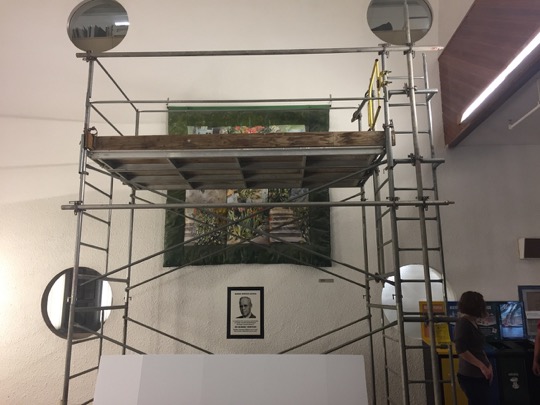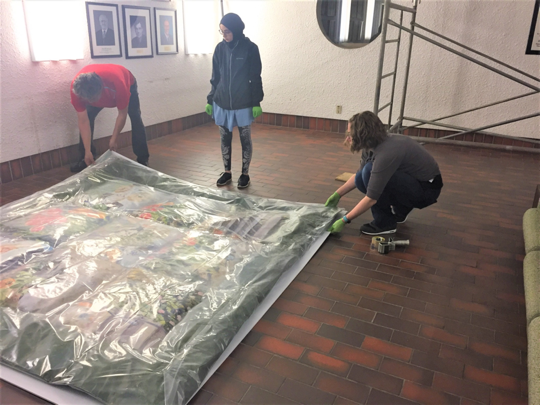UAM Summer Internship Blog 2019: The Dust Settles on Public Artwork
Fatme Elkadry - 26 July 2019
Beautiful B.C. Thermal Blanket – Gloria (1982.14) by Canadian artist, Gathie Falk, has adorned the walls of the Agriculture Forestry Centre for the past 25 years. This work of art appears to be a quilted textile, but it is a painting. It is one of the University of Alberta Art Collection’s approximately 7,000 pieces, which displays some of its collection across campus for public enjoyment. Public artwork serves society by generating meaning, wonder, and discovery in spaces.
Art is exposed to many threats when on public display. Public places generally have harsh environments with uncontrolled temperatures, humidity, and pollutants in the air. Although the art displayed on campus is checked regularly by Museums and Collections staff, some pieces require a little extra attention to preserve them from deterioration. When possible, it is important to provide artwork with periods of rest from public display. Due to renovations in the Agriculture Forestry Centre, the Faculty of Agriculture, Life & Environmental Sciences requested that we remove the painting to keep it safe. Museums and Collections staff decided to take advantage of the deinstall by dry surface cleaning the painting and storing it in a room where the temperature, humidity, and light are controlled.
The deinstallation team included Jennifer Bowser (Collections Management Advisor, Registration/Preventive Conservation), Tom Hunter (Collections Assistant, University of Alberta Art Collection), Emerald Johnstone-Bedell (Assistant Curator, University of Alberta Art Collection), and myself. Our day was packed with action: we deinstalled, transported, examined, treated, and stored the painting.
The team had intricately planned the deinstallation and transportation of the piece, which helped us through every unexpected obstacle. Since we did not have firsthand knowledge of the methods used to install the artwork, we revised our plans as the day unfolded. Despite many unknown variables that could not be planned for, such as vehicle traffic, the deinstallation and transportation of the painting went smoothly.
We then used dry surface cleaning techniques to carefully remove the 25-years worth of dust that had accumulated on the painting. Dry surface cleaning is the manual removal of any dirt from the surface of a piece that may damage it or obstruct its visibility. Using a soft brush, we carefully swept the dust away from the surface of the painting into a vacuum. This technique granted us greater control of what was removed from the surface, and at what pace. Dry surface cleaning ensured the preservation of Falk’s painting so we may continue to enjoy and learn from it for many years to come.
This was an exciting opportunity for me to understand the versatile skills required in planning and implementing a museum project. Planning the deinstallation of the painting required months of research, coordination with a variety of people, and preparation of materials. Everyone from the team exhibited their strong attention to detail and the ability to problem-solve on their feet. I also got a close look at the effects that an uncontrolled environment can have on public artwork and how we can intervene to preserve it. Watch the film to see the team in action as they expertly brave scaffolding and layers of dust!


